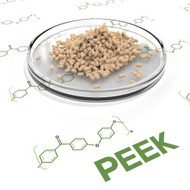PEEK: High Temperature Engineering Polymer
History
Polyether ether ketone (PEEK) is a colorless, organic, semicrystalline polymer that belongs to the thermoplastics family. The demand for materials that could withstand extreme conditions and meet the requirements of demanding applications led to the development of PEEK in the 1970s by Imperial Chemical Industries (ICI). It was introduced to the market nearly a decade later under the trade name Victrex PEEK. The material gained popularity in aerospace, automotive, and industrial applications due to its high performance and excellent mechanical, chemical, and thermal properties. By the 1990s, characteristics such as biocompatibility, high strength, and transparency to X-rays (radiolucency) made PEEK suitable for use in medical fields, with applications such as orthopedic and spinal implants. PEEK has continued to find new applications in industries including oil and gas, electronics, and 3D printing.
Quick Highlights
- Polyether Ether Ketone (PEEK) is a semicrystalline high-performance thermoplastic developed in the 1970s by Imperial Chemical Industries (ICI) and brought to market under the trade name Victrex PEEK a decade later.
- PEEK became a popular choice for the aerospace, automotive, and industrial sectors due to its excellent mechanical, chemical, and thermal properties. By the 1990s, its use had expanded to the medical sector due to its high strength and biocompatibility, with notable applications in orthopedic and spinal implants, as well as dentures.
Synthesis
PEEK synthesis relies on step-growth polymerization through the dialkylation of bisphenolate salts. Typically, hydroquinone is treated with sodium carbonate to generate the reactive disodium salt of hydroquinone in situ, which subsequently reacts with 4,4-difluorobenzophenone. This reaction requires high temperatures of 300 °C (572 °F) and polar aprotic solvents. The degree of crystallinity in the polymer reflects its characteristics and can be fine-tuned through processing conditions used to mold the polymer. Typically, PEEK is processed through injection molding near its melting temperature (343 °C / 649.4 °F). Alternatively, fused deposition modeling (FDM) enables granular PEEK to be processed into filaments and 3D-printed parts. Particularly, PEEK filaments have enabled its application in the medical sector, for example, in dentures. PEEK can also be processed in its solid state; CNC milling machines are employed to produce thermostable, electrically, and thermally insulating parts.
Quick Highlights
- The synthesis of PEEK involves step-growth polymerization of bisphenolate salts and requires high temperatures of up to 300 °C (572 °F) and polar aprotic solvents.
- Processing conditions can be used to fine-tune the polymer’s crystallinity and characteristics; typical processes include injection molding, fused deposition modeling, and CNC milling.
Mechanical Properties
PEEK exhibits excellent mechanical properties with high tensile strength, rigidity, and impact resistance, enabling its use in load-bearing parts and structural applications. It has a high strength-to-weight ratio, allowing it to maintain durability across various applications while reducing the part’s weight. This can offer various benefits, such as enhanced fuel efficiency in the aerospace and automotive industries. Additional advantages of this material include a low friction coefficient and high wear resistance, which enhance its lifespan and reduce maintenance requirements.
PEEK is predominantly chemically inert, demonstrating excellent resistance to most acids, bases, organic solvents, and even certain highly corrosive chemicals, like sulfuric acid. However, at high temperatures, it can be susceptible to degradation by some strong acids, halogens, halogenated compounds, and aliphatic hydrocarbons. PEEK also exhibits exceptional resistance to hydrolysis, making it suitable for use in moist or wet environments. Its resistance to steam and hot water enables applications in medical tools and devices that require repeated autoclave sterilization.
Quick Highlights
- PEEK exhibits high tensile strength, rigidity, and impact resistance.
- It also demonstrates a high strength-to-weight ratio, low friction coefficient, and high wear resistance
Chemical Resistance
PEEK is predominantly chemically inert, demonstrating excellent resistance to most acids, bases, organic solvents, and even certain highly corrosive chemicals, like sulfuric acid. However, at high temperatures, it can be susceptible to degradation by some strong acids, halogens, halogenated compounds, and aliphatic hydrocarbons. PEEK also exhibits exceptional resistance to hydrolysis, making it suitable for use in moist or wet environments. Its resistance to steam and hot water enables applications in medical tools and devices that require repeated autoclave sterilization.
Quick Highlights
- PEEK demonstrates excellent chemical resistance to most acids (including strong acids like sulfuric acid), bases, and organic solvents. However, it is susceptible to degradation at high temperatures by halogens, halogenated compounds, certain strong acids, and aliphatic hydrocarbons.
- PEEK also exhibits excellent resistance to hydrolysis, including steam and hot water.

Thermal & Dimensional Stability
PEEK exhibits high thermal stability, meaning it can be continuously used at temperatures as high as 250 °C (482 °F) without degradation. With a melting point of 343 °C (649.4 °F), it can withstand even higher temperatures if exposure time is limited. This property makes PEEK ideal for high-heat applications, such as in engines and industrial machinery. Additionally, PEEK’s inherent flame-retardant properties resist combustion, and compared to other materials, it emits low amounts of smoke and minimal toxic gases. These characteristics are crucial for meeting strict fire safety requirements in public transportation or construction applications.
PEEK has excellent dimensional stability, which enables it to withstand high temperatures without deforming under load. This characteristic is vital in applications such as precision machined parts, where maintaining shape and mechanical properties under varying temperatures is essential. Additionally, PEEK exhibits stable electrical insulating properties even in high-heat environments, which enables its use in applications such as connectors and electronic components.
Quick Highlights
- PEEK has high thermal stability, withstanding temperatures of 250 °C (482 °F) without degradation; it can tolerate short-term exposure to even higher temperatures due to its melting point of 343 °C (649.4 °F).
- PEEK possesses inherent flame-retardant properties; it resists combustion and emits low amounts of smoke and minimal amounts of toxic gases.
- PEEK maintains its shape and mechanical properties under varying temperatures, demonstrating high dimensional stability.
- PEEK also has stable electrical insulating properties, even in high-heat environments.
Biocompatibility
One of PEEK’s most important characteristics in modern applications is its biocompatibility, meaning that the material can safely stay in the human body without causing adverse effects. Its excellent mechanical properties, combined with biocompatibility, have led to its FDA approval for long-term medical implants and prosthetics. A further characteristic supporting these applications is an elastic modulus similar to that of human bone, allowing PEEK to exhibit flexibility similar to bone matter, which is superior to titanium-based alternatives, reducing stress on surrounding bone tissue.
Quick Highlights
- PEEK exhibits excellent biocompatibility and an elastic modulus similar to human bone, enabling its use in long-term medical implants and prosthetics. It is also FDA-approved.
Sustainability
Compared to many other high-performance materials, PEEK has a lower environmental impact, though it also faces some challenges in terms of sustainability. Its long lifespan and durability reduce the need for frequent replacements, lowering overall material consumption and reducing energy and waste management demands. Although difficult to separate from other materials, PEEK can be recycled and reprocessed, a service sometimes offered by certain manufacturers. However, recycling is somewhat limited due to high costs. Production of PEEK is energy-intensive due to the high temperatures required for polymerization. Efforts are underway to develop more efficient processes with lower emissions. PEEK’s lightweight properties help offset production impact by lowering fuel consumption, particularly through its applications in transportation. Its chemical stability and low leaching mean that, providing it is responsibly disposed of, the material does not release toxic compounds into the environment. However, as a non-biodegradable material, PEEK can persist in landfills, making closed-loop recycling practices crucial to minimizing its environmental impact. Overall, while its production is energy-intensive, its long lifespan, recyclability, and potential to reduce fuel consumption make it a relatively environmentally sustainable high-performance material.
Quick Highlights
- Compared to many other high-performance materials, PEEK faces fewer challenges in terms of sustainability. While its production is energy-intensive, its long lifespan, recyclability, and potential to reduce fuel consumption (as a lightweight material used in the aerospace and automotive sectors) make it a relatively environmentally sustainable material.
- Novel, more efficient, and less energy-demanding production processes are paramount for further limiting its environmental impact. As a non-biodegradable material, PEEK requires closed-loop recycling practices, which currently face some limitations due to high costs and the difficulty of separating PEEK from other materials.
Discover the exceptional strength and versatility of PEEK / Polyether ether Ketone in our Material - Nuts & Bolts category. Explore the innovative applications of this high-performance thermoplastic material, known for its superior mechanical properties and resistance to extreme conditions. Elevate your projects with PEEK, a game-changing material for nuts, bolts, and beyond. .
Elevate your projects with our Nylon PA 66 / 50% Glass Fibre Reinforced Pan Cross Head Bolts. Designed for superior strength and thermal resistance, these bolts are ideal for load-bearing applications in automotive, industrial, and consumer goods industries. With enhanced mechanical properties and a high heat deflection temperature, our glass fiber reinforced material ensures reliable performance even under demanding conditions.
Browse our premium PEEK plastic bolts, nuts, and washers. These high strength, chemical, and heat-resistant fasteners are designed for demanding industrial, non-metallic, and extreme environment applications.





